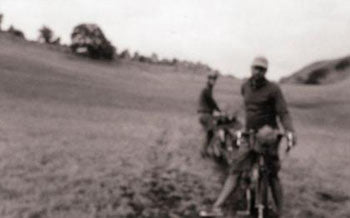The Big Picture

A bike should fit you. Most riders today are riding bikes that by our standards, are too small. They make you lean over too far, which puts too much weight on your hands, and too much strain on your arms, neck, and back.
A bike should be appropriate for how and where you ride it, and your fitness. If you're a mid-50s rider of moderate fitness, but ride fewer than 3000 miles per year, and you want to ride longish and steepish hills, the standard road gearing you'll find on virtually any stock road bike, is too high. You don't need a top gear more than 100 inches. You'll appreciate a low gear of 23-inches or less. Your big ring should be less than 50t, you middle ring should be 36t or 34t, and your small ring should be 24t or 26t. The biggest cog on your cassette should be at least 27t, and preferably 32t.
If you weigh more than 150 lbs and/or are not racing (meaning, even if you weigh 122 lbs and don't race), the smallest tire you should ride is 27mm wide. You may be able to ride comfortably and safely and problem-free on skinnier tires, but there's no benefit to the skinniness, and the drawback is more strain on your wheels, your frame, and your body; and less traction, and you're more likely to get a pinch flat. Air is so light and so cheap and so beneficial that you shouldn't minimize the amount in your tires. I'm not saying you should maximize it (because at some point you need more rubber for that, and that adds weight and affects frame and brake clearance). But you shouldn't minimize it, either.
For non-competitive riding, it's hard to justify tires smaller than 28mm.
Actually, it's hard to justify tires smaller than 32mm. Unless your justification amounts to, "I just bought some, I ride them, I say I like 'em, and that's final." Logic always loses arguments with emotion!
All of our frames are lugged steel. Steel, because it's the best material for frames, in terms of toughness, longevity, proportions, repairability, and safety; lugged, because it's better to create a joint with a low-stress sleeve of beautiful steel, than to merely melt steel together, or even joint it with brass fillets.
You may personally prefer welded frames, or fillet-brazed frames, and that's fine. We prefer them lugged, and so that's all we make.
Modern bikes have too many gears. By "too many," I mean for non-racing uses. It's a stretch to say you need more than this: (1) a really high high, (2) a normal high, (3) a high medium, (4) a medium, (5) a low medium, (6) a high low, (7) a medium low, (8) a low low, and (9) a super low low. But it's foolish to moan about "more than we need," and we know that from years of experience. So now our attitude toward the number of cogs on the rear hub is: Seven is heaven, eight is great, nine is fin e, ten is kind of getting ridiculous, but it won't kill you.
e, ten is kind of getting ridiculous, but it won't kill you.
The worst thing about modern frames isn't the materials or joining methods, but their design. The designers don't know how long to make the forks, where to put the holes in the fork crowns, or where to put the seat stay bridges. The fork blades are too short, the brake holes in the crown are too high, and the rear brake bridges are too low. As a result, these frames don't accept practical tires. They accept racing tires, and racing tires are not practical for non-racing use. Yes, you can ride a racing bike on a Sunday ride, or a non-competitive group ride or a century or charity ride, but those bikes are less comfortable, more likely to get a flat, and in many cases are one broken rear spoke away from being unrideable. Plus, you can't put fenders on them for wet weather riding, and if you can't do that and you live in someplace other than Arizona or Southern California, it's nuts. You wouldn't buy a car without a top, but a bike you can't put fenders on is the same thing.
Materials and methods.
The only bikes we love, and therefore the only ones we make and sell, are lugged steel. Steel is the best material for frames because it's strong, tough, safe, repairable, and less likely to need repair. It endures hardships such as accidents and nicks and gouges that kill lesser frames, and although it's not unbreakable, it's less likely to break, and is more easily repaired, than is a frame of any other material.
Steel frames tend to have slender tubes, which are not only aesthetically pleasing in the same way that a fly rod or a 1910 airplane is, but also are more practical when it comes to fitting tires between them. Because steel is more rigid by volume than are other materials, the tubes don't have to be as fat. And skinny tubes look better and fit tires better.
The best way to join steel tubes is with lugs. Any other way is a compromise, a concession to price, expediency, or skill. It makes sense to add material to the outside of stressed frame joints, and that's what a lug does. A weld concentrates the stress. A fillet (as in a fillet-brazed frame) acts luglike, and is preferable to a tig-weld, but we prefer lugs for their interesting and beautiful looks. There is beauty of a sort in a tig-weld or a fillet, but there's just not a lot to look at. Yes, a bike is a tool, but tools can be beautiful and functional, and the best ones are both.
Forks should have crowns. Fork blades should have a low radius that continues, without increasing or straightening in the least, all the way to the dropout. That's how we like them, anyway.
